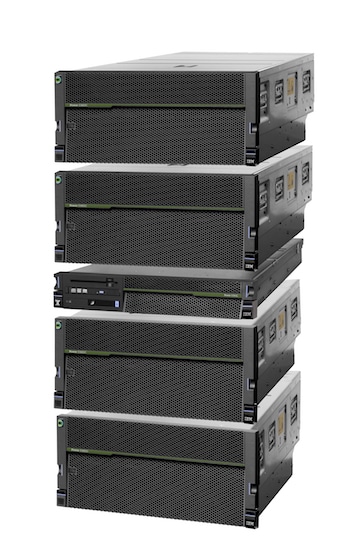At IBM Edge 2016, IBM has announced a range of cloud-ready systems, services, and solutions designed to make the movement of data, applications, and services much simpler in a hybrid cloud-environment. These include Power Systems for cloud, z Systems for cloud, and IBM Spectrum Copy Data Management and Protect. IBM also announced a series of new and expanded partnerships with organizations, such as with Red Hat, with an emphasis on hybrid cloud.
IBM Power E880C
Power Systems for cloud comes with integrated OpenStack-based cloud management and elastic consumption models, allowing for the transformation of IT infrastructure to a local cloud for AIX, IBM, and Linux. It also gives quick-and-easy access to computer services in the IBM Cloud.
IBM zSystems Operational Insights is the company’s new SaaS-based solution that offers analytical insight on cloud operations, which helps to promote a more efficient and performance-driven environment. IBM claims that this means better business and application decisions based on trends and embedded expertise on performance data via a handy GUI interface/dashboard. In addition, the new IBM Common Data Provider allows for the near real-time and efficient consumption of operational data by the clients’ cloud or local enterprise operational analytics platform.
IBM’s new Spectrum Copy Data Management and Protect solution promotes operational and development agility and efficiency for both new and traditional applications. It does this by offering detailed and efficient management of data copies. Moreover, IBM indicates that it has added cloud object-storage options to its hybrid-cloud solution integration, which can be used during hybrid cloud deployments.
Continuing with IBM’s slate of announcements, the company has also unveiled a series of both new and revamped partnerships regarding hybrid cloud environments:
- Canonical and IBM have announced that Ubuntu OpenStack is now available through LinuxONE, z Systems, Power Systems, and OpenPOWER-based systems such as the new line of LC servers. IBM indicates that they will provide solutions based on Canonical’s software and IBM servers, allowing clients to leverage Canonical’s line of solutions across the three platforms; all with simplified and automated OpenStack management.
- IBM and Hortonworks are entering the market with a joint relationship that will have the latter company’s Hadoop distribution available on POWER. As a result, IBM says that clients will be able to use Open Enterprise Hadoop as a component of their data architectures at no cost, allowing for a range of new applications. It will also improve existing ones with further data sources. Additionally, with Hortonworks HDP available on POWER-based systems, IBM client will be able to more options available to them when selecting a “top tier distribution” for Hadoop and Spark. IBM says that this will allow them to take advantage of the performance, scalability, and acceleration features of the POWER8 platforms.
- IBM is now working with Mirantis to develop reference architectures. The focus of this partnership is to allow Mirantis OpenStack to manage compute nodes hosted on IBM Power Systems servers as well as the providing ability to validate a range of core applications to run its OpenStack private cloud. IBM indicates that this integration will bring its OpenStack-based private cloud management to the POWER platform, which will give their customers the option to leverage IBM Power Systems for data-driven workloads in a very efficient and effective manner in their data center via Mantis’ OpenStack cloud management.
- IBM’s POWER architecture is also now supported on NGINX Plus R10, the company’s latest release of its commercial load balancer and web accelerator. Coupling NGINX Plus and POWER gives enterprises new and improved agility and allows them to scale their infrastructure and application delivery solution on virtually any environment, including public, private and hybrid clouds, and bare metal.
- Lastly, IBM is extending their partnership to help drive the adoption of hybrid cloud among their clients. Using a joint engineering process and a closer collaboration between their products, both companies are slated to announce solutions based on key components of Red Hat’s portfolio of open source products, such as Red Hat Enterprise Linux, Red Hat Virtualization, and Red Hat Linux High Availability offerings. With this newly expanded collaboration, Red Hat and IBM also plan to allow improved compatibility between their platforms and to bring Red Hat’s offerings to clients who previously only worked in distributed environments. They will be working to provide joint solutions through enabling Red Hat solution on IBM’s next-gen Power Systems; introducing new high-performance computing capabilities for leading-edge research deployments; and developing high-availability capabilities for Power Systems.





 Amazon
Amazon